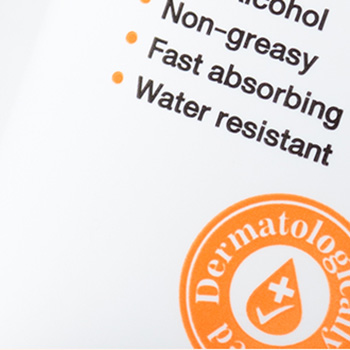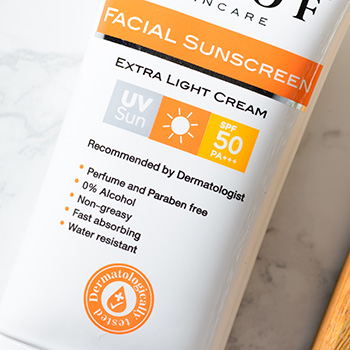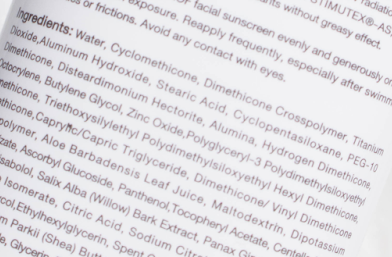You probably know that you need to apply sunscreen while you’re laying out on the beach. However, dermatologists recommend that you use a sunscreen any time you’re going to be outside for more than 20 minutes, even in the wintertime. You should wear sunscreen even when it’s shady or overcast. The sun’s UV (ultraviolet) rays can begin to cause skin damage in just 15 minutes! This damage can even lead to skin cancer.
Part 1 Choosing a Sunscreen
1. Look at the SPF number.
“SPF” refers to a sunscreen’s “sun protective factor,” or how effectively it blocks UVB rays. The SPF number reflects the amount of time it takes to sunburn wearing the sunscreen vs. not wearing the sunscreen.

- The SPF number can be tricky, because its protection doesn’t increase proportionally. Thus, SPF 60 is not twice as good as SPF 30. SPF 15 blocks about 94% of UVB rays, SPF 30 blocks about 97%, and SPF 45 blocks about 98%. No sunscreen blocks 100% of UVB rays.
- The American Academy of Dermatology recommends an SPF of 30 or higher. The difference between extremely high SPFs is often negligible and not worth the extra money.
2. Choose a “broad-spectrum” sunscreen.
SPF refers only to the ability to block UVB rays, which cause sunburn. However, the sun also emits UVA rays. UVA rays cause skin damage, such as signs of aging, wrinkles and dark or light spots. Both increase your risk of skin cancer. A broad-spectrum sunscreen provides protection from both UVA and UVB rays.
- Some sunscreens may not say “broad-spectrum” on the packaging. However, they should always state whether they protect against UVB and UVA rays.
- Most broad-spectrum sunscreens contain “inorganic” components such as titanium dioxide or zinc oxide, as well as “organic” sunscreen components such as avobenzone, Cinoxate, oxybenzone, or octyl methoxycinnamate.
3. Look for a water-resistant sunscreen.
Because your body expels water through sweat, you should look for a water-resistant sunscreen. This is especially important if you are going to be very active, such as running or hiking, or if you’ll be in the water.

- No sunscreen is “waterproof” or “sweat proof.” In the US, sunscreens cannot market themselves as “waterproof.”
- Even with water-resistant sunscreen, reapply every 40-80 minutes or as directed on the label.
4. Decide what you like.
Some people prefer spray sunscreens, while others prefer thick creams or gels. Whatever you decide, make sure you apply a thick, even coating. The application is as important as the SPF and other factors: if you don’t apply it properly, the sunscreen won’t do its job.
For acne-prone individual, take care in selecting your sunscreen. Look for those that are designed specifically for your face and will not clog pores. These often have higher SPF (15 or higher), and are less likely to clog pores or increase acne breakouts.

- Many acne-prone individuals find that zinc oxide-based sunscreens tend to work best.
- Look for "non-comedogenic", "will not clog pores", "for sensitive skin", or "for acne-prone skin" on the labels.
5. Go home and try a small portion around your wrist.
If you see any allergic reaction or skin problem, buy a different sunscreen. Repeat the process until you find the right sunscreen, or talk to your doctor about recommended brands if you have sensitive skin or allergies.

(Cr: janniesday)
- Itching, redness, burning, or blisters are all signs of an allergic reaction. Titanium dioxide and zinc oxide are less likely to cause allergic skin reactions.
Part 2 Applying a Sunscreen
1. Check the expiration date.
The FDA requires sunscreen to retain its protective power for at least three years from the date of manufacture. However, you should always note expiration dates. If the date has passed, ditch the old bottle and buy some new sunscreen.
- If your product doesn’t have an expiration date when you purchase it, use a permanent marker or a label to write the purchase date on the bottle. This way you’ll know how long you’ve had the product.
- Obvious changes in the product, such as color changes, separation, or different consistency, are signs that the sunscreen has expired.
2. Apply before going out in the sun.
The chemicals in sunscreen take time to bind to your skin and become fully protective. Apply your sunscreen before you go out.
- Sunscreen on the skin should be applied 30 minutes before you go out into the sun. Lip sunscreen should be applied 45-60 minutes before going into the sun.
- Sunscreen needs to :"cure" on the skin to be fully effective. This is especially important in the water-resistance factor. If you put on sunscreen and jump into the pool 5 minutes later, much of your protection will be lost.
3. Use enough.
One of the biggest mistakes in using sunscreen is to not use enough. Adults usually need about one ounce -- a palm-ful, or about a shot glass full -- of sunscreen to cover exposed skin.
- To apply cream or gel sunscreen, squeeze a dollop into your palm. Spread it all over the skin that will be exposed to the sun. Rub the sunscreen into your skin until you can't see the white anymore.
4. Apply sunscreen to your face.
Your face needs even more sunscreen than the rest of your body, as many skin cancers occur on the face, especially on or around the nose. Some cosmetics or lotions may contain sunscreen. However, if you’re going to be outside for more than 20 minutes (total, not at a time) you’ll want to apply a facial sunscreen too.
- Many facial sunscreens come in cream or lotion form. If you use a spray sunscreen, spray it into your hands first, then apply it to your face. It's best to avoid spray sunscreens on the face if possible.
- The Skin Cancer Foundation has a searchable list of recommended facial sunscreens.
- Use a lip balm or lip sunscreen with an SPF of at least 15 on your lips.
- If you are bald or have thin hair, remember to apply sunscreen to your head, too. You can also wear a hat to help protect against sun damage.
Sources : wikiHow